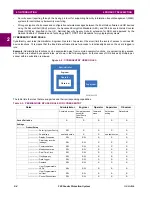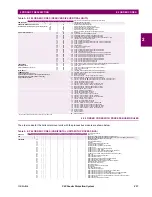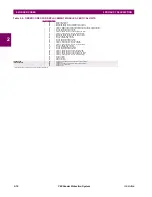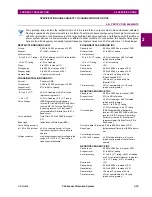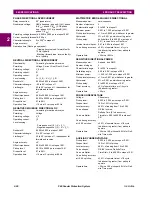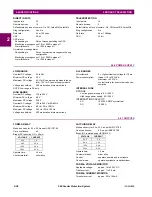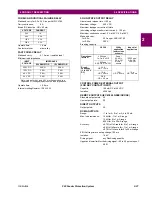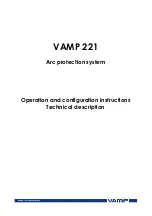
2-18
F60 Feeder Protection System
GE Multilin
2.3 SIGNAL PROCESSING
2 PRODUCT DESCRIPTION
2
(EQ 2.2)
Current harmonics are estimated based on raw samples with the use of the full-cycle Fourier filter. Harmonics 2nd through
25th are estimated.
True RMS value for the current is calculated on a per-phase basis. The true RMS can be used for demand recording or as
an input signal to Time Overcurrent function, if the latter is intended for thermal protection. The true RMS is calculated as
per the widely accepted definition:
(EQ 2.3)
RMS values include harmonics, inter-harmonics, DC components, and so on, along with fundamental frequency values.
The true RMS value reflects thermal effects of the current and is used for the thermal related monitoring and protection
functions.
Protection and control functions respond to phasors of the fundamental and/or harmonic frequency components (magni-
tudes and angles), with an exception for some functions that have an option for RMS or fundamental measurements, or
some function responding to RMS only. This type of response is explained typically in each element's section in the instruc-
tion manual.
Currents are pre-filtered using a Finite Impulse Response (FIR) digital filter. The filter is designed to reject DC components
and low-frequency distortions, without amplifying high-frequency noise. This filter is referred to as a modified MIMIC filter,
which provides excellent filtering and overall balance between speed and accuracy of filtering. The filter is cascaded with
the full-cycle Fourier filter for the current phasor estimation.
Voltages are pre-filtered using a patented Finite Impulse Response (FIR) digital filter. The filter has been optimized to reject
voltage transformers specific distortions, such as Capacitive Voltage Transformer (CVT) noise and high-frequency oscilla-
tory components. The filter is cascaded with the half-cycle Fourier filter for the voltage phasor estimation.
The URs measure power system frequency using the Clarke transformation by estimating the period of the waveform from
two consecutive zero-crossings in the same direction (negative-to-positive). Voltage or current samples are pre-filtered
using a Finite Impulse Response (FIR) digital filter to remove high frequency noise contained in the signal. The period is
used after several security conditions are met, such as true RMS signal must be above 6% nominal for a certain time and
others. If these security conditions are not met, the last valid measurement is used for a specific time after which the UR
reverts to nominal system frequency.
Synchrophasors are calculated using a patented convolution integral algorithm. This algorithm allows use of the same time
stamped samples, which are used for protection and taken at the same sampling frequency. This allows URs to use one
sampling clock for both protection algorithms and synchrophasors.
Synchrophasors on firmware versions 7.23 and up have been tested and certified to meet IEEE C.37.118-2011 and
C.37.118.1a-2014 standards for both metering and protection classes with outputs available up to 60 synchrophasors per
second for the metering class and 120 synchrophasors per second for the protection class. Synchrophasors measurement
are also available via IEC 61850-90-5 protocol.
Contact inputs threshold is settable in the firmware with 17, 33, 84, 166 VDC settings available. Inputs are scanned every
0.5 ms and can be conditioned for the critical applications, using debounce time timer, settable from 0.0 ms to 16.0 ms.
Contact inputs with auto-burnishing are available as well, when external contacts are exposed to the contamination in a
harsh industrial environment.
All measured values are available in the UR metering section on the front panel and via communications protocols. Mea-
sured analog values and binary signals can be captured in COMTRADE format with sampling rates from 8 to 64 samples
per power cycle. Analog values can be captured with Data Logger, allowing much slower rates extended over long period of
time.
Other advanced UR order code options are available to support IEC 61850 Ed2.0 (including fast GOOSE, MMS server,
61850 services, ICD/CID/IID files, and so on), IEEE 1588 (IEEE C37.238 power profile) based time synchronization, Cyber-
Sentry (advanced cyber security), the Parallel Redundancy Protocol (PRP), IEC 60870-5-103, and so on.
2
±
46
rated A
( )
⋅
I
RMS t
( )
1
T
---
i
2
t
( )
t
d
t T
–
(
)
t
=
Summary of Contents for F60
Page 10: ...x F60 Feeder Protection System GE Multilin TABLE OF CONTENTS ...
Page 30: ...1 20 F60 Feeder Protection System GE Multilin 1 5 USING THE RELAY 1 GETTING STARTED 1 ...
Page 138: ...4 28 F60 Feeder Protection System GE Multilin 4 2 FACEPLATE INTERFACE 4 HUMAN INTERFACES 4 ...
Page 454: ...5 316 F60 Feeder Protection System GE Multilin 5 10 TESTING 5 SETTINGS 5 ...
Page 500: ...7 14 F60 Feeder Protection System GE Multilin 7 1 COMMANDS 7 COMMANDS AND TARGETS 7 ...
Page 508: ...8 8 F60 Feeder Protection System GE Multilin 8 2 FAULT LOCATOR 8 THEORY OF OPERATION 8 ...
Page 522: ...10 12 F60 Feeder Protection System GE Multilin 10 6 DISPOSAL 10 MAINTENANCE 10 ...
Page 660: ...B 116 F60 Feeder Protection System GE Multilin B 4 MEMORY MAPPING APPENDIX B B ...
Page 706: ...E 10 F60 Feeder Protection System GE Multilin E 1 IEC 60870 5 104 APPENDIX E E ...
Page 718: ...F 12 F60 Feeder Protection System GE Multilin F 2 DNP POINT LISTS APPENDIX F F ...
Page 728: ...H 8 F60 Feeder Protection System GE Multilin H 2 ABBREVIATIONS APPENDIX H H Z Impedance Zone ...
Page 730: ...H 10 F60 Feeder Protection System GE Multilin H 3 WARRANTY APPENDIX H H ...

